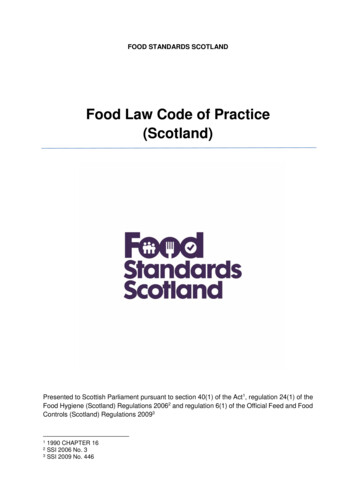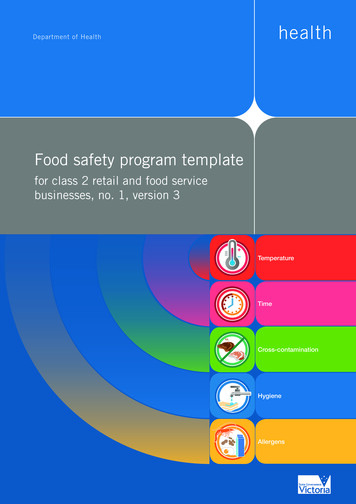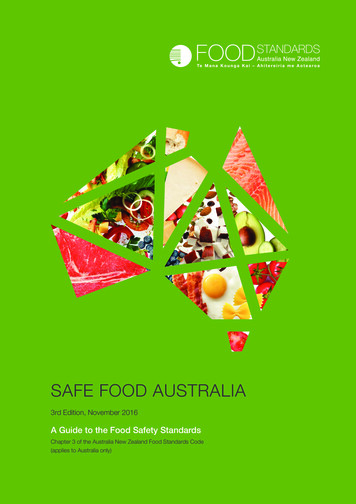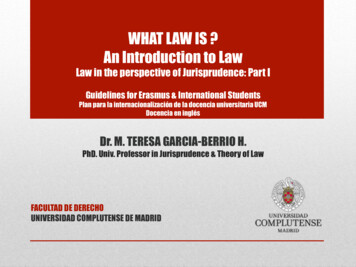
Transcription
FOOD STANDARDS SCOTLANDFood Law Code of Practice(Scotland)Presented to Scottish Parliament pursuant to section 40(1) of the Act1, regulation 24(1) of theFood Hygiene (Scotland) Regulations 20062 and regulation 6(1) of the Official Feed and FoodControls (Scotland) Regulations 2009311990 CHAPTER 16SSI 2006 No. 33 SSI 2009 No. 4462
ForewordThe role of the Food Law Code of Practice (the Code) is to ensure an effective, consistentand proportionate approach to the delivery of Food Law and Official Controls by LocalAuthorities across Scotland, in order to protect food safety and the wider interests ofconsumers.This Code was last published in 2015 to reflect the creation of Food Standards Scotland(‘FSS’) on 1st April 2015. This 2019 revision of the Code, incorporates changes reflecting thefollowing: The Local Authorities’ Better Regulation obligations under the Scottish Regulators’Strategic Code of Practice. The Food Standards Scotland Regulatory Strategy. New and modified legislation. The introduction of the Scottish National Database. The creation of the Scottish Food Crime and Incidents Unit within FSS to tackle seriousand / or complex fraudulent conduct and regulatory non-compliance.The Food (Scotland) Act 2015 provides the primary legislation that reflects therecommendations of the Scudamore Expert Advisory Group agreed with Scottish Ministersand the Food Standards Agency in November 2013. The application of the powers of the Food(Scotland) Act 2015 are detailed within this Code.Local Authority delivery of Food Law and Official Controls is an essential part of Scotland’sinfrastructure for Public Health protection. This updated Code sets out how Food StandardsScotland and Local Authorities will work in partnership to discharge their statutory duties andhelp maintain consumer confidence in the regulation of the food supply chain in Scotland.Scotland has a thriving food and drink industry which has a strong reputation both at homeand abroad, and the Code is a key component of our regulatory system to ensure the higheststandards of food safety and authenticity are maintained. The updated Code clearlyrecognises the important role of Local Authorities in contributing to sustainable economicgrowth, and the need to have due regard to the principles of better regulation in the way FoodLaw and Official Controls are delivered.Date: 31 January 20192
TABLE OF CONTENTSSECTION 1 - ADMINISTRATION . 161INTRODUCTION . 162STATUTORY AND GENERAL OBLIGATIONS ON FOOD AUTHORITIES . 173INTER-AUTHORITY MATTERS . 223.1Co-ordination of Advice and Enforcement . 223.2Operating in other areas . 223.3Regional and Local Liaison . 233.4Enforcement liaison arrangements between District and County Council FoodAuthorities in England and Wales . 244QUALIFICATIONS AND COMPETENCE . 254.1. General Qualification and Experience Requirements . 254.2. New Appointments . 264.3. Training . 264.4. Training Records. 274.5. Contracted or Temporary Staff . 274.6. Sampling . 274.7. Lead Officer . 284.8. Specific Qualification and Competency Requirements . 294.8.1.Officers Appointed to Carry out Food Hygiene Official Controls . 294.8.2.Inspection of Specialist or Complex Processes . 304.8.3.Inspection of Establishments Subject to Approval under Regulation (EC) No853/2004. 314.9. Qualifications and Awarding Bodies – Food Hygiene . 314.9.1.Service of Hygiene Improvement Notices (See also sub-section 15) . 324.9.2.Service of Improvement Notices (Food Safety Act Section 10) . 324.9.3.Service of Hygiene Emergency Prohibition Notices and or Emergency ProhibitionNotices (See also sub-section 16). 324.9.4.Service of Remedial Action Notices and or Detention Notices (Regulation 9 ofthe Food Hygiene (Scotland) Regulations 2006) (See also sub-section 18) . 334.10. Food Standards: Officers Appointed to Carry Out Official Controls . 333
4.10.1.Qualifications and Awarding Bodies – Food Standards . 344.10.2.Quality Assurance Systems . 354.11. Food Hygiene and Food Standards . 354.11.1.Inspection, Detention & Seizure of Foodstuffs (See also sub-section 19). 354.11.2.Non-Official Control Interventions . 354.12. Alternative Enforcement Strategies . 364.13. Qualification Requirements for interventions . 365CONFLICTS OF INTEREST . 385.1. Introduction . 385.2. Avoiding Potential Conflicts of Interest . 385.3. Enforcement within Local Authority Run Establishments . 386FOOD BUSINESS ESTABLISHMENT RECORDS . 396.1. Introduction . 396.2. Database of Food Business Establishments . 396.3. Access to information . 396.4. Registration of Food Business Establishments . 406.4.1.Introduction . 406.4.2.Exemptions . 406.4.3.Registration of New Food Business Establishments . 406.4.4.Time Frame for Registration . 416.4.5.Registration Form . 416.4.6.Sites on which there is more than one Food Business Establishment . 416.5. Lists of Food Business Establishments . 416.5.1.Requirements of Regulation (EC) No 882/2004 . 416.6. Action on Receipt of Completed Registration Form . 426.6.1.Registration Certificates / Confirmation of Receipt . 426.7. Changes to Activities after Registration . 436.8. Moveable Establishments . 436.8.1.Mobile Food Business Establishments, Ships, Aircraft, Trains and Coaches . 436.8.2.Vending Machines . 436.8.3.Markets . 444
6.9. Non-Registered Establishments Thought to Be Engaged in Activities Subject toRegulation (EC) No 852/2004 . 447CROWN AND POLICE PREMISES . 457.1. Introduction . 457.2. Powers of Entry Food Hygiene (Scotland) Regulations 2006 . 457.3. Powers of Entry (under the Act) . 457.4. Obtaining Entry to Crown and Police Premises . 457.5. Conduct . 467.6. Photographs . 477.7. Liaison with the Home Authority and or FSA/FSS . 47SECTION 2 - COMMUNICATION . 488MANAGING INCIDENTS AND ALERTS . 488.1. Food Incidents . 488.1.1.Definitions . 488.1.2.A Schematic Representation of Incident Reporting . 498.1.3.Documented procedure . 508.1.4.Hazardous Incidents . 508.1.5.Non-hazardous Incidents . 508.1.6.Deliberate contamination and malicious tampering . 518.1.7.Food hazards associated with outbreaks of foodborne illness . 518.1.8.Action by the Food Authority – Hazardous Food Incidents . 528.1.9.Action by the Food Authority – Non-Hazardous Food Incidents . 538.1.10.Out of Hours Service. 548.1.11.FSS Incidents Team Contact details . 548.2. Food Alerts / Information Notices . 548.2.1.Definitions . 548.2.2.Responding to Food Alerts for Action (FAFA) . 558.2.3.Facilities for receiving Allergy Alerts (AA), Product Recall Information Notices(PRIN), Food Alerts for Action (FAFA) and Updates . 558.2.4.Action by Food Authorities . 568.2.5.Media Relations . 568.2.5.1. Localised Incidents . 568.2.5.2. Serious Localised & Non-Localised Food Incidents . 565
9FOOD CRIME AND FOOD FRAUD . 579.1. Definition . 579.2. Scottish Food Crime and incidents Unit (SFCIU). 579.3. Reporting Food Fraud or Food Crime to FSS. 589.4. Intelligence. 5810COMMUNICATION . 5910.1. Disclosure of information. 5911FSS AND FSA COMMUNICATION AND GUIDANCE . 6011.1. Introduction . 6011.2. Guidance Issued to Food Authorities . 6011.3. Enforcement Consistency . 6012INFORMATION TO BE SUPPLIED TO FSS . 6112.1. Information requirements: . 6112.2. Matters Relating to Food Incidents . 6112.3. Concerns about Industry Practice . 6112.4. Matters Relating to Establishments Subject to Approval under Regulation (EC) No853/2004. 6112.5. Quality of Live Bivalve Mollusc Production and Relaying Areas . 6212.6. Matters Relating to the Delegation of Tasks Related to Official Controls . 6212.7. Matters Relating to Liaison Arrangements with Other Member States or ThirdCountries . 6212.8. Lead Officer . 6212.9. Chief Executive, Head of Food Service and Authorised Officers . 6312.10.The Scottish National Database . 6313LIAISON WITH OTHER MEMBER STATES AND 3RD COUNTRIES . 6413.1. Introduction . 6413.2. Trans-border Matters . 6413.3. Category A. Trans-border matters. 646
13.4. Category B. Trans-border matters. 6513.5. Category C. Routine Liaison between Local Food Control Authorities of MemberStates . 6513.6. Enquiries to Other Member States . 6613.7. Enquiries from Other Member States . 6613.8. Disclosure of Information to Other Member States . 66SECTION 3 – GENERAL ENFORCEMENT . 6814APPROACH TO ENFORCEMENT . 6814.1. Introduction . 6814.2. Enforcement Information . 6814.3. National Food and Feed Compliance Spectrum . 6814.4. Food Law Enforcement Policies . 6914.5. Communication with Multi-site Food Businesses . 7014.6. Mandatory Requirements and Advice . 7114.7. Use of Food Safety Act 1990 and Regulations Made Under the Act . 7114.8. Powers of Entry, Search and Seizure: Human Rights Act 1998 . 7114.9. Informal Approach. 7214.10.Reporting to the Procurator Fiscal . 7215HYGIENE IMPROVEMENT NOTICES AND IMPROVEMENT NOTICES . 7415.1. Introduction . 7415.2. When to use Hygiene Improvement Notices (Food Hygiene (Scotland) Regulations2006 Regulation 6 . 7415.3. When Hygiene Improvement Notices are not appropriate . 7415.4. When to use Improvement Notices (Section 10 of the Act) (see also Section 4.9.2) . 7415.4.1.16When Improvement Notices are not appropriate . 75PROHIBITION PROCEDURES (SEE ALSO SUB-SECTION 4.9.3) . 7616.1. Introduction . 7616.2. The Food Hygiene (Scotland) Regulations 2006 (as amended) Procedures . 7616.2.1.When to Use Hygiene Emergency Prohibition Notices (Regulation 8) . 767
16.2.2.Health Risk Conditions Where Use of Hygiene Prohibition Procedures May beAppropriate . 7616.2.3.Health Risk Conditions Where Prohibition of Premises May be Appropriate . 7616.2.4.Health Risk Conditions Where the Prohibition of Equipment may be Appropriate. 7716.2.5.Health Risk Conditions Where Prohibition of a Process May be Appropriate . 7716.3. Health Risk Condition No Longer Exists: Certificate (Regulation 7(6) (a) andRegulation 8(8)) / Health Risk Condition Remains in Existence: Certificate (Regulation7(7) (b) and Regulation 8(9) (b). 7716.4. Voluntary Procedures (Food Hygiene) . 7816.5. Action when a Hygiene Prohibition Order has been made against a Person (Regulation7(4)) . 7916.6. Lifting of Hygiene Prohibition Orders Against Persons (Regulation 7(6) (b) andRegulation 7(8) . 7917FOOD SAFETY ACT 1990 EMERGENCY PROHIBITION PROCEDURES. 8017.1. When to Use Emergency Prohibition Procedures (Section 12 of the Act) . 8017.2. Imminent Risks of Injury to Health where the use of Emergency Prohibition Proceduresmay be appropriate . 8017.3. Voluntary Procedures . 8017.4. Action When a Prohibition Order has Been Made Against a Person (Section 11(4) ofthe Act) . 8117.5. Lifting of Prohibition Orders Against Persons (Section 11(6)(b) and 11(8) of the Act) 8218 REMEDIAL ACTION NOTICES (RAN) AND DETENTION NOTICES (SEE SUBSECTION 4.9.4 OF THIS CODE) . 8318.1. Introduction . 8318.2. Remedial Action Notices / Detention Notices . 8319DETENTION AND SEIZURE (SEE ALSO SUB-SECTION 4.11.1) . 8519.1. Introduction . 8519.2. The Food Hygiene (Scotland) Regulations 2006 Regulation 27 . 8519.3. Detention of Food . 8519.4. Seizure of Food . 8619.5. Notices of Detention and Seizure . 8719.6. Withdrawal of Detention of Food Notice . 878
19.7. Dealing with Batches, Lots or Consignments of Food . 8719.8. Voluntary Procedures . 8819.9. Destruction or Disposal of Food . 8819.10.Food Information Law. 8919.10.1. Introduction . 8919.10.2. Scope of the powers . 8919.10.3. Application of Detention and Seizure Powers. 9019.10.4. Use of Detention Notices . 9019.10.5. Seizure of foods . 9119.10.6. Compensation. 9119.11.Novel Foods . 9119.11.1. Introduction . 9119.11.2. Scope of the powers . 9119.11.3. Detention of unauthorised novel foods . 9219.11.4. Withdrawal . 9219.11.5. Seizure . 9219.11.6. Compensation. 9220TEMPERATURE CONTROL REQUIREMENTS . 9320.1. Introduction . 9320.2. General Approach to Temperature Checks . 9320.3. Temperature Deviations Resulting in a Breach of Regulation 30 / Schedule 4 of theFood Hygiene (Scotland) Regulations 2006 . 9420.4. Checking and Calibration of Enforcement Measuring Thermometers etc. . 9421FOOD WASTE . 9622DISTANCE SELLING AND MAIL ORDER . 9723BOTTLED WATERS . 9824MICROBIOLOGICAL CRITERIA REGULATION. 9925IMPORT OF FOOD FROM THIRD COUNTRIES . 100SECTION 4 - INSPECTIONS . 10126FOOD SAFETY AND GENERAL FOOD LAW . 1019
26.1. Introduction . 10127INTERVENTIONS . 10227.1. Introduction . 10227.2. Interventions . 10327.3. Unannounced Official Controls. 10327.4. Records pertaining to Official Control Interventions (see sub-section 33) . 10427.5. Food Hygiene Interventions . 10427.6. Food Standards Interventions . 10527.7. Definitions . 10527.8. Inspections and Audits . 10627.8.1.Carrying out an inspection or audit. 10627.8.2.Initial Inspections of New Food Establishments . 10727.8.3.Samples. 10727.9. Frequency of Intervention at Establishments. 10727.10.Primary Production . 10827.11.Establishments Subject to Annex 5 . 10827.12.Establishments Intervention Rated Category A or B for Food Hygiene or Category Afor Food Standards . 10827.13.Establishments Intervention rated category C for food hygiene or category B for foodstandards . 10927.14.Establishments Intervention Rated D for Food Hygiene. . 10927.15.Establishments Intervention Rated E for Food Hygiene or Category C for FoodStandards . 10927.16.Revising the Intervention type and Intervention rating . 11027.17.Timing of Interventions . 11027.18.Need to Defer Planned Intervention . 11127.19.Combining Interventions. 11227.20.Larger Food Establishments. 11227.21.Factory, Freezer and Fishing Vessels – Hygiene Inspection . 11227.22.Inspection of Moveable Establishments / Premises: Trains and Long DistanceCoaches . 11310
28HOW INSPECTIONS SHOULD BE CARRIED OUT . 11428.1. Inspections – General . 11428.2. Food Hygiene Inspections.
FOOD STANDARDS SCOTLAND Food Law Code of Practice (Scotland) Presented to Scottish Parliament pursuant to section 40(1) of the Act1, regulation 24(1) of the Food Hygiene (Scotland) Regulations 20062 and regulation 6(1) of the Official Feed and Food Controls (Scotland) Regulations 20093 1 1990 CHAPTER 16 2 SSI 2006 No. 3 3 SSI 2009 No. 446










